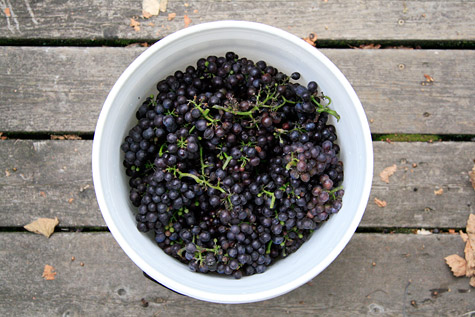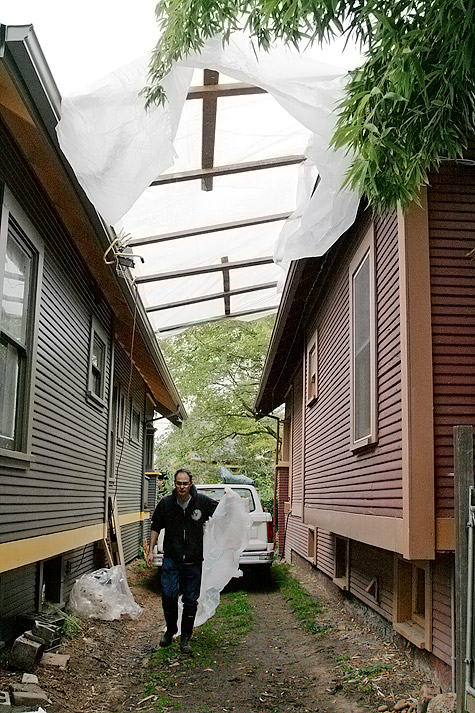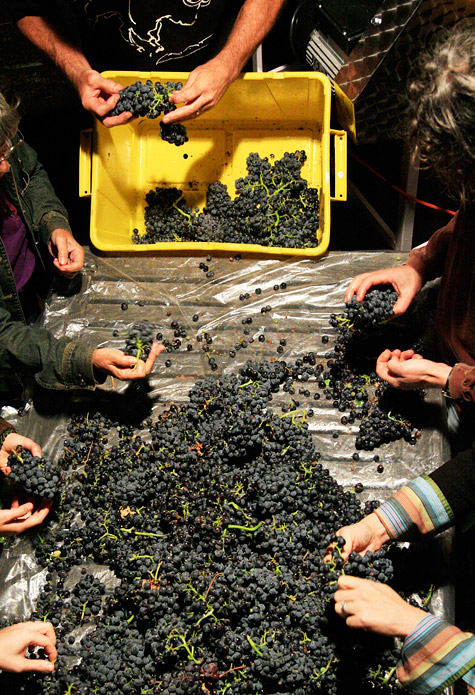Archive for October, 2010
About this supposedly crappy vintage

I don’t have any skin but grape skins in the game, so it’s been interesting to watch the pitched battle unfolding to define this vintage — before its wines have even finished fermenting, much less transmogrified into something someone could actually taste and evaluate.
On the one hand, there’s everything you’ve been reading in the media, or heard whispered by wine-wags in restaurants, wine shops and tasting rooms: the vintage is a complete wash. Low crop yields, waves of botrytis and powdery mildew, grapes wheezing toward ripeness (if at all), and the coup de grâce, ravenous birds. All have pounded the industry with the most challenging and grim harvest in decades.
On the other hand, you’ve got winemakers who’ve actually been out there, working the vines and the fruit. The ones I’ve talked to are stoic, but guardedly optimistic, arguing that the cooler weather has produced beautiful, elegant wines that truly express the uniqueness of Oregon – for the first time in years.
Keep in mind, of course, that their livelihood is utterly dependent on consumers’ preconceptions about a vintage. If a consensus develops that a vintage is great, it’ll fly off the shelves; but if the buzz is otherwise — or worse, that it’s a disaster — they’ll have trouble even moving it out of the bottling room. Would you fan the flames of the latter if your income depended on it? I didn’t think so.
So who’s right?
I think one answer may lie in the bucket you see above. That’s the sum total of the Giraud “estate” harvest from my back yard, about 25 pounds. Before the rains bore down a week or so ago, I frantically clipped what fruit I could salvage: probably half unripe and mildewed, half passable, and all told, 20 brix. Without some sugar, that would produce wine a shade above 11% alcohol, fine for Riesling but anemic for Pinot Noir.
So there you go: proof. The buzz is right, the vintage sucks.
But not so fast. I’m a rank, drooling amateur when it comes to farming grapes. Most years I’m lucky even to get a good crop of mildew, much less viable, fermentable fruit. That I got vaguely healthy grapes as high as 20 brix this year is nothing short of a miracle, in fact.
So if a yahoo with a hoe can do that, what do you think someone with years of training and experience can do? Take, for example, the fruit we brought in from Oracle Vineyard in the Dundee Hills, farmed by people who actually know what they’re doing. Totally clean, exceptional flavor, vivid acidity. Its numbers look great, and well within the ballpark of ideal for Pinot Noir.
I’ve heard a lot of that around the Valley. Sure, some horror stories, and certainly low yields, a tsunami that will roll dire economic consequences toward the shores of those without deep enough pockets. But at the same time, tales of great flavors and a chance to make a truly Oregon Pinot Noir, one balanced on the razor’s edge of ripeness where the varietal truly comes alive.
So that’s my read. In the hands of people who know what they’re doing — and didn’t panic — this vintage is going to produce some disarmingly elegant wines. Will Robert Parker anoint them with high scores? Unlikely. It’ll be nowhere near the syrah-like California style he favors. But will it earn high marks from those smart enough to snap up the tragically few that make it to market? Oh, yeah.
In the end, maybe what’s scariest about this vintage is that it’s kind of a ticking time bomb for less talented winemakers and growers. Everyone’s reputation will probably survive the year, but when 2010 wines hit the shelves, there will be nowhere to hide: the true measure of talent will be unflatteringly revealed in the glass.
9 commentsOne last haka for 2010

Ka Upane! Upane Kaupane! Whiti te rÄ! HÄ«!
[Up the ladder! Up to the top! The sun shines! Rise!]
5am Wednesday morning, we rise for one last trip up to the altar of sun, praying for Cabernet, Mourvedre and Viognier imbued with the power of Gods!
Yep, that’s a hangover in the making, for sure. Anyway, we may need more than the ritual sacrifice at Stonehenge for this final road trip of vintage 2010: the grower says it’s raining lightly out there tonight, and while I’m sure the fruit can stand a little water, it’d be nice to have a say in how much.
See you on the other side, fellow mortals!
No commentsGetting away with it

Okay, it’s probably bad luck, but I have to say it: as the rain came sweeping into SE Portland yesterday afternoon, I felt the roguish elation that only comes when you feel you’ve gotten away with something. That’s because, as storm clouds gathered, I’d spent yesterday dismantling the rain cover we rigged to shelter the Cab Franc crush (above), wiping down the side of the house, hauling to compost all the grape detritus we’ve produced so far, and returning the truck and cycling home. Only then did it start to rain.
Ha, ha, ye Gods! I laugh at you! Les Garagistes has thwarted you aga {ker-POWWWW n-ZZATZ!! bliNDING FLAsh!!!}
…
{a whiff of barbecue; breeze wafting through a smoldering crater … }
2 commentsGrenache by the numbers
холни масиOur numbers are back from the lab, and they look better than we thought. 26.9 brix is high, but a lot better than the 29 we’ve been getting on the hydrometer. And look at that pH: ideal acidity!
The tricky bit will be the fructose and glucose number, which translates to approx 17.7% alcohol — fine for powering machinery, but not for powering a decent meal. So we’ll water back 1.5 brix, see how it feels, and then maybe notch it back another brix or so near the end of fermentation. I’m told by a winemaking hero of ours that our open-top fermenters will probably also dissipate some of the alcohol, so with luck, we’ll cruise into bottle around 15%. Not exactly what you’d call an “elegant” wine, but with the right massage it’ll be in balance, which is all we really want, anyway.
Les numeros:
brix 26.9 degrees glucose + fructose 298 g/L pH 3.47 titratable acidity 5.8 g/L tartaric acid 4.44 g/L L-malic acid 2.93 g/L potassium 1610 mg/L alpha-amino compounds 135 mg/L ammonia 72 mg/L yeast assimilable nitrogen 194 mg/L (as N)
Considering that sugar, a couple of Gs wondered whether all that sorting might have been a bad idea. Elaine and I did some math last night and calculated that assuming we culled 100 lbs of fruit from what we got, the cull would have had to be an average of 14 brix to have swayed the overall sugar by 1 bx. 14 brix is the sugar content at veraison, when the grapes just start turning color, so while we did toss some green ones, the majority were well into color. So, suffice it to say that what we tossed couldn’t have affected the sugar significantly. But because unripe fruit is about more than sugar, it still probably improved the overall flavor.
No commentsWe’re (literally) in the MIX!
Landing on some doorsteps a couple weeks ago, and on newsstands even as we speak, the latest issue of the Oregonian’s MIX Magazine has a nice feature on us you should check out. (The site is still featuring the September issue, however.)
The basement of Matt Giraud’s Southeast Portland bungalow looks an awful lot like a mad scientist’s laboratory. There are chemistry tools, beakers and small scales on a well worn workbench, and every nook is filled with imposing equipment.
But oak barrels, a wine press and a 124-gallon steel fermentation tank reveal that this isn’t a space for DNA sequencing. This is where Giraud and a collective known as Les Garagistes gather every fall to make small batches of wine for their own enjoyment…
Hmmm, DNA sequencing… kind of a good idea, actually. Why drink seven wines when you can drink just one? Prepare to tremble before our mighty Caber-lot Syrpino-vedre, you puny, normally-sequenced humans!
Okay, then. As I was saying, in order to run the story during harvest, MIX’s Beth Nakamura shot the photography for it a year ago (now that’s planning ahead!), when we were bottling and James concocted a magnificent poached egg and meurette dish. So if you check it out and find yourself thinking, “man, those hairstyles are sooooo 2009″ — well, that’s why.
Thanks much to Grant Butler for the great write-up, and for stopping by for a tour (sadly, it doesn’t take long…) and a conversation about all things Garagiste. I think he liked our Oracle Pinot Gris — though that assumes his eyes bulge out and he grips his throat whenever he really likes a wine…
Find out where you can get a copy here — and then save the hassle next time by subscribing!
No commentsCrushing Grenache

The pace is picking up here at our subterranean lair. Cabernet Franc and Pinot Noir are looming in the next few days, but last week, it was Grenache — the first time we’ve tackled this Rhône varietal. I made the trip with Garagiste Whit in mid-80s Ford F-150 which was loaned to us by Bill, a warm and generous friend of Erik’s now retired from the carpentry business. Pulling into the vineyard in that rig made us feel a little less like the yahoos we are.
The vineyard manager warned us that the sugars might be high, but we saw a lot of unevenness in the clusters, so we set up our first-ever sorting table (pictured above). As we later learned, the sugars were indeed high, but I’m convinced that culling the surprising percentage of unripe and sometimes green berries will make this a purer wine. After all, grapes aren’t just about sugar, and the bitter, vegetal flavor of unripe ones can really swerve a wine.
In any case, since we’ve never made Grenache, I can’t say whether the fruit was typical, or whether this oddball year made it this way, but this may give Pinot Noir a run as our most challenging harvest. The sorters diligently scanned every cluster for leaves, green berries, and the telltale pink/magenta tint of unripeness. Keen eyes even pulled out a little bunch rot, though the harvest was overwhelmingly healthy.
But now it’s safely soaking; probably start fermenting mid-week. More pics just a click away…
Read more
Syrah and Merlot numbers
Courtesy of the good folks at ETS Labs, we’ve now got some scientified digits to noodle on the Syrah and Merlot.
The top line, I suppose, is the acidity this year: it’s excellent. I don’t think we’ve ever gotten Washington fruit that didn’t need some pH adjustment to bring into safe territory. But this year, Washington’s weather mirrored Oregon’s, only a little warmer and with a lot less rain. That cool summer kept acidity lower than usual (heat and in particular warm nights tend to evaporate acidity), the result being lively wines right out of the chute.
That doesn’t mean these wines won’t require a few “Jesus units” (“water into wine,” as one wine pundit quipped), but we’re within striking range of well-balanced wines — again, especially because of those acid numbers. A good harbinger of a great vintage, I’d say…
Actual numbers after the jump.
Read more
